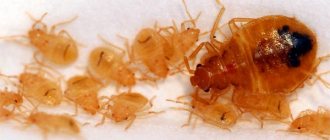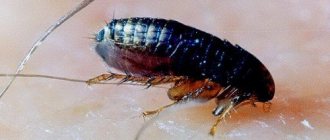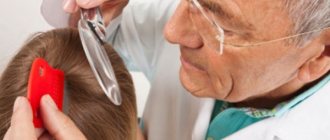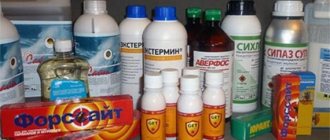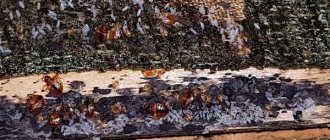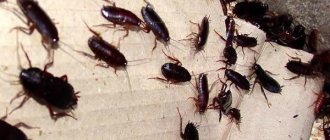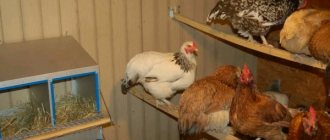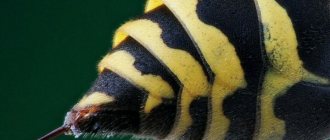- about the author
- VK profile
Svetlana Tarasova
Hairdresser-stylist with more than 8 years of experience, expert in the field of haircuts, styling, hair care, coloring.
Depression, stress, and severe nervous shock do not pass without leaving a trace on the body. Experiences lead to a weakening of the immune system, as a result the body cannot suppress the activity of viruses and bacteria, so a person develops various diseases. There is a theory that systematic stress can cause head lice. Is this so, let's figure it out.
Lice and psychosomatics - can lice appear from stress, myth and reality
Many people are interested in whether lice can appear due to nervousness, because often during times of stress a person begins to experience prolonged itching.
There are several versions of the connection between head lice and psychosomatics:
- Lice are constantly present on the scalp, but in an inactive state. As soon as the immune system fails due to nervous tension, they awaken and begin to multiply.
- In a state of stress, the human body releases special substances that attract parasites.
- Pediculosis is transmitted at the genetic level , and lice come to the surface after severe nervous tension.
- Negative emotions lead to the formation of painful bumps on the head , in which insects love to live.
- When a person is very excited, lice multiply more actively and quickly infest the scalp.
Reference! None of these versions have found scientific confirmation; scientists are sure that the itching that appears during stress is nothing more than the development of a skin disease.
Lice are transmitted only from an infected person.
A person under stress is attractive to lice: is this true?
Contrary to popular belief, lice prefer to settle not on dirty, but on clean heads. Dead skin flakes, fat, and other secretions prevent insects from getting to blood, which is their only food product. So lice is not a disease of dirty people or people with reduced social responsibility. Anyone can get lice, regardless of their social status or hygiene habits.
However, when a person washes poorly or rarely, he acquires a specific smell. It does not wash away sweat, which also attracts parasites. In a stressful situation, this smell intensifies, even if a person maintains hygiene. A person who smells is more attractive to any parasite, including lice. Relatively speaking, if a louse chooses whom it wants to move to - someone who is clean and odorless, or someone under stress who “smells of adrenaline” - she will choose the second one.
In addition, a person scratches himself when stressed, but does not associate the itching with the appearance of lice. So he may miss the moment of infection. Very rarely, but this also happens: some people in a nervous state, on the contrary, become resistant to itching and ignore insect bites. They, too, may not notice the appearance of parasites in themselves.
All this leads to the fact that lice multiply, and a person notices this only when the situation becomes critical. In any case, the cause of lice is another person, not stress.
Can a child have lice due to nervous conditions?
According to statistics, every fifth child suffers or has suffered from head lice . Children are at risk for this disease because their bodies are weaker, and they are less picky about their contacts. But at the same time, lice infection in children is no different from adults. Like an adult, a child becomes infected from a carrier and nervous experiences have nothing to do with this.
Reference! Lice do not come from dirt, they are not transmitted by animals, and the only source of their transmission can be an infected person.
Why do lice appear on the head - the reasons for the appearance of lice in humans
The only way is for parasites to spread from one infected person to another. Usually, lice crawl from head to head during close contact, and also if people neglect the rules of personal hygiene, use other people's accessories, personal hygiene products, like to dress or try on things from someone else's shoulder, or sleep in a bed that is not their own. Sometimes you can catch lice in a bathhouse, sauna, or in inexpensive hotels, where they are not too concerned about the cleanliness of the rooms and bed linen. There are cases of lice infestation in a hairdresser or even on public transport. To generalize, in any place where there is an infected person.
Lice symptoms
It’s not difficult to understand that you have lice. The main thing is to respond in time to warning signs, such as an itchy scalp that continues even after taking a bath or shower and gets worse at night. You may be able to notice bite marks that have a bluish color, or even the parasites themselves on the hair, which you can find out for sure by taking a fine-toothed comb and thoroughly combing your hair. This will definitely give results. At the same time, if you want to crush an insect, you will hear a quiet but quite obvious click.
Lice by Louise Hay
Louise Hay, like many other psychologists, believes that the reason for the appearance of lice on a person’s body may be internal qualities that prevent him from being self-confident. In her opinion, a person cedes power to another organism, that is, lice take over and not only them. An insecure person allows himself to be parasitized not only by insects, but also by people. such people often lead an isolated lifestyle, focus on trifles and do not attach due importance to their appearance.
To get rid of parasites, Louise Hay recommends becoming mentally stable. This will require the mobilization of not only physical, but also emotional strength. Anti-pediculosis agents, of course, should also be used.
Do lice appear on their own?
There are many different theories about spontaneous lice disease due to nervous disorders. However, the very posing of the question - whether lice can appear on their own - does not seem entirely reasonable and logical. Scientists have long explored and studied all the possible causes of the appearance of parasites, in which there was no place for nervous shocks.
The absurdity of the proposed concept is confirmed by the following facts:
- the louse is unable to fly or jump;
- the only way for it to migrate is to crawl from one object to another;
- There is no way it can appear out of nothing and nowhere (if we exclude the mystical view of the problem).
Types of lice: head, pubic, body lice
Even non-pediculosis specialists have long known that the only realistic version of the unexpected appearance and reproduction of lice is their transfer from the body of a sick person or things that he used.
The main causes of lice infection
As has already been said more than once, a person on whose body lice live is a source of infection. Moreover, its infectiousness is not related to the number of individuals parasitizing on its body.
There are the following methods of transmission of pediculosis:
- Contact – infection occurs through close contact with an infected person; insects crawl onto the body, hair, and things of a healthy person. This is the most common route of infection with head lice.
- Genital - as a rule, in this case, infection with pubic lice occurs - with close contact of the pubic areas, the lice move to the body of the new owner.
- Household - lice can be contracted through pillows, mattresses, bed linen, hats, combs, hair clips, towels and other household items. After these items are used by an infected person, lice may remain on them for some time, therefore, infection can occur even after several days.
- Through the water – lice can remain alive in water for 2 days, so public bathing areas are also dangerous. And we're not just talking about swimming pools - the sea and sand can also be a source of infection.
When a louse lands on the body of a new host, it immediately looks for easily accessible places to live. Depending on the stage of the life cycle, the insect begins to reproduce immediately or after a short time. An adult lays several larvae every day: head - 4, pubic - 3, body - 16.
Head and body lice spread most quickly in places where there are large crowds of people - barracks, prisons, dormitories, children's groups, as well as in places where sanitary standards are not observed - habitats of the homeless, antisocial families, places where there is no access to water and hygiene is difficult .
General information
As long as there are at least a couple of lice in the world, their lineage will not be interrupted. Parasites multiply quickly, and after laying eggs, an adult appears within 2 weeks. That is why the appearance of one lice often provokes an entire epidemic.
Where do lice come from? They crawl from a sick person to a healthy one. Lice can also appear as a result of contact with contaminated things:
- players;
- clothes;
- telephones;
- toys, etc.
Pediculosis can be contracted in wardrobes, swimming pools, gyms, shops, and public transport.
The reason for the appearance of pubic lice is sexual contact with the owner of the parasite, as well as the use of towels and bedding that were used by an infected person. The patch mainly digs into the skin at the very base of the pubic hair, but can creep to the axillary area and eyebrows.
Pediculosis can be contracted in public places
TOP best methods for getting rid of lice and nits
Currently, there are a lot of methods to combat pediculosis. And everyone can choose the one that will be as harmless as possible to the body. If lice are found in a child under 3 years of age, the child is prone to allergies or is asthmatic, parents should definitely consult a doctor so that he can recommend a safe drug. The same applies to pregnant women. Most often in these cases, mechanical removal of insects is practiced, as well as the use of the safest folk remedies.
Drugs
Medications for the treatment of head lice should be used in accordance with the following rules:
- Do not use them against nits and lice parasitizing on eyelashes and eyebrows.
- Preparations containing chemical components are not approved for use in children under 2 years of age.
- Use with caution for bronchial asthma and allergies.
- If after one use of the drug the insects do not die, it should be replaced with another.
- After the procedure for exterminating insects, you must comb your hair with a thick comb to remove dead lice and comb out nits.
- After using antiparasitic drugs, it is prohibited to dry your hair with a hairdryer - insects may fly away in different directions.
- After removing lice, you should refrain from using conditioners and hair masks for some time..
- After the antiparasitic drug is washed off from the hair, You should not wash your hair for 2-5 days.
The best effect in the fight against pediculosis can be achieved using a combination of chemical and mechanical removal of insects . The easiest way for men is to shave their heads bald, but girls with long hair will have to spend a lot of effort combing their hair.
The most popular means:
- Ivermectin;
- Albendazole;
- Levamisole;
- Butadion.
Sprays
The most effective sprays in the fight against head lice are:
- Couple Plus (France). The duration of action of the drug is 10 minutes, it is used for all types of lice. It has low toxicity and can be used by children over 2.5 years of age. . Contraindications: bronchial asthma, pregnancy, lactation period.
- Full Marks (Great Britain). Not allowed for use on children under 5 years of age and asthmatics. Active ingredients: cyclomethicone, isopropyl myristate.
- Lavinal (Ukraine). Despite the fact that the mixture in the can is oily, it is easily distributed throughout the hair, as it is supplied in the form of a spray. Allowed for children from 2 years old.
- Paranit (Belgium). Also an oily mixture, the active substances are isoprene and dimethicone. Toxicity is average, has a slight specific odor. It has a suffocating effect on insects. Duration of action of the drug is 15 minutes.
- Pediculen Ultra (Russia). The active ingredients are anise oil and capric acid. Exposure time 30 minutes. Allowed for children over 5 years old. Pregnant and nursing mothers, as well as patients with acute dermatosis, are prohibited from using.
Ointments
The following types of ointments are most often used to combat human parasites:
- Sulfuric – destroys lice and is used for microbial diseases.
- Serormertnaya – an effective remedy – rubbed into the skin.
- Mercury – not such an effective drug, it needs to be used repeatedly.
- Turpentine – has a weak effect, but has an antiseptic effect.
- Benzyl benzoate cream – destroys insects in 5 hours.
- Bornaya – in addition to the anti-pediculosis effect, it has a fungicidal effect.
- Permethrin cream – destroys not only insects, but also their larvae.
- Knicks – contains permethrin, approved for children from 6 months.
Shampoos
Effective lice shampoos are:
- Veda-2 (Russia). Complete destruction of parasites occurs after 40 minutes; to destroy nits, the product must either be kept on the hair longer or reused. To completely get rid of insects, the procedure must be repeated after 12 days.
- Paranit (Belgium). 100% results are observed when the product is kept on the hair for half an hour. The active substance envelops the body of the insect and suffocates it.
- Hygia (Bulgaria). Contains acetic acid and may cause a burning sensation. You need to keep the product for half an hour. If the burning sensation is very strong, the shampoo should be washed off and another drug should be used.
- Knicks (Russia). The active component permethrin, in addition to destroying parasites, the shampoo actively treats the scalp.
- Nittifor (Hungary). It is a low-toxic drug, but is contraindicated for children, pregnant and lactating women.
Folk remedies
Folk remedies have been proving their effectiveness for centuries; infusions and decoctions that are prepared at home are no less effective than pharmaceutical preparations, but safer and more affordable.
You can get rid of lice using various folk recipes, including:
- mint leaves with pomegranate juice;
- kerosene;
- black class=”aligncenter” width=”600″ height=”438″[/img]
- ointment from angelica root and white bird cherry;
- decoction of elecampane root;
- burdock decoction;
- geranium oils;
- cranberry juice;
- ointment from wild rosemary and hellebore;
- tar soap and much more.
How to distinguish stress from lice
In fact, in some cases it turns out to be quite difficult to distinguish the signs of lice. The fact is that the breeding period is two weeks; it is during this time that adult individuals ready for reproduction can hatch from the nits. Lice are considered tenacious parasites, so getting rid of them is not so easy. Stress is a condition that is associated with critical tension, to which not only an adult, but also a child can be exposed.
Head lice and stress have several common signs that are worth looking out for. First of all, this is the occurrence of itching. A person’s scalp may itch for the following reasons:
A person’s scalp may itch for the following reasons:
- It is not uncommon for scalp dermatitis to occur. It is this that is accompanied by the appearance of red spots, which makes it seem as if something is crawling on the head.
- To the question whether lice can be caused by nerves, the answer is unequivocal - no, but an allergy may well appear. The fact is that the body, having experienced stress, becomes more vulnerable, so an allergic reaction can occur even to shampoo, from which nothing similar happened before.
- People with hypersensitive skin may experience discomfort from light touch.
- Nervous itching is most often localized in the scalp.
- If the skin becomes dry and begins to peel, this can also be the cause of itching.
Several of these signs may lead a person to believe that he has actively begun to develop lice. Naturally, as a preventive measure, it is sometimes worth examining the head and at the first symptoms, consult a doctor who will carry out the correct treatment or completely rule out the presence of lice.
Prevention of head lice
Prevention of head lice is as follows:
- Avoid contact with people living in unsanitary conditions as much as possible.
- Avoid casual sexual contact with a person who has signs of lice.
- Use only your own hygiene products and household items.
- Wash bedding and clothes regularly.
- Regularly check your child's head for lice and nits.
- Use special repellents that people cannot smell.
- Periodically use anti-pediculosis shampoos for prevention purposes.
Analyzing all of the above, we can conclude that head lice and psychosomatics are not related things . Lice are carried exclusively by people, and even a completely mentally stable and happy person can become infected with lice. As for the itching, which often accompanies a person in moments of mental stress, this is most likely a manifestation of dermatitis, and, by the way, it can also occur due to nervousness.
- about the author
- VK profile
Psychosomatics of lice
Parasitologists confidently declare that the appearance of lice on nerves is nothing more than a myth. Until now, no one has identified or substantiated the psychosomatic theory of lice. On the other hand, experts do not exclude the possibility that the skin of an excited person is more vulnerable to parasites.
Psychosomatics
This is due to the fact that all small insects are sensitive to odors. And in a person who acutely perceives troubles and is nervous on any occasion, the sweat glands begin to work intensively. They emit a strong odor that attracts parasites. However, there is no direct connection between nervousness and the appearance of parasites.
It is also quite logical to ask why not all people get lice, even if they have been at risk for some time? The answer to this question has not yet been received, which in no way contradicts the conclusions of specialists in the psychosomatics of lice.
What if not lice?
As already mentioned, there are diseases that have similar symptoms to lice. These include:
Psoriasis
One of the main symptoms of the disease is severe itching, which can worsen during times of nervous tension. Many patients, until they find out the real diagnosis, live in full confidence that lice are parasitic on their body.
Dermatitis
Dermatitis is almost always a concomitant condition with nervous breakdowns, emotional overexcitation and stress. Characterized by severe itching and redness in areas where scratching occurs.
Scabies
It is this disease that is most often confused with pediculosis. Just in this case we are talking about subcutaneous parasites, namely mites that do not come to the surface of the skin, causing severe itching. But this disease cannot be caused by stress, but is transmitted through direct contact with the skin of an infected person. Scabies can be distinguished from pediculosis by the absence of external marks of bites and nits.
More about pediculosis
Pediculosis is a disease that involves parasites infecting human skin.
There are three types of lice, each of which can cause great health problems for people.
All types of lice feed on blood. They have a similar structure and body color. Many people believe that lice and nits are the same thing, but this is not entirely true.
Lice are adult parasites that cause discomfort to humans by biting through their skin. Nits are lice larvae that are in the first stage of insect development.
Head lice live on the scalp. Most often they are concentrated on the back of the head, the crown of the head and the skin behind a person’s ears.
The shafts of human hair provide reliable protection for them; moreover, it is to their roots that lice attach their eggs.
Pubic lice are slightly smaller in size and affect the genital area, groin and armpit areas, as well as the eyelash and eyebrow line.
The behavior of parasites is similar to that of head lice.
Body lice bite a person only when his body is in close proximity to the textiles in which they live.
Not a single person is immune from the attacks of all these types of insects. Head and pubic lice can be acquired from contact with an infected person, and this contact does not necessarily have to be close.
Of course, the myth that lice can jump from person to person has long been debunked, but scientists have proven that parasites crawl quickly and swim well.
Therefore, you can become infected with them not only in long lines at the store or while traveling on public transport, but also when swimming in pools or indoor reservoirs.
To maintain their vital functions, lice need to eat at least four times a day. They make each bite in a new place, as they love to crawl over the scalp.
The ideal temperature for head and pubic lice to exist is the temperature of the human body.
Once in a cooler environment, lice live no more than three days.
Evidence that nerve lice are a myth
So are all these beliefs false or reality?
Nerve lice are fiction and nothing more. They can become infected due to dirt and neglect of cleanliness.
Other myths about parasites
Besides the fact that lice come from nerves, there are several other mythical beliefs. These beliefs are more tenacious than facts that have a scientific evidence base.
- For example, many people are convinced that nits and lice are insects of different origins. The proof that nits are parasitic eggs has not quite become common knowledge among the average unenlightened person.
- Myth #2 is that lice come from dirt. Even in Ancient Greece, observations were carried out that proved that lice cannot be born even from dirt. They are more willing to move from true sources to dirty conditions, and this is a fact, but it is impossible to appear from nowhere in dirty places.
- There is a third stupid myth about these small parasites. There is a belief that lice are the fact that lice are represented by special cancer cells that can arise from nerves and die exclusively at the moment of death of the owner. The fairy tale seems absurd and even funny.
Pediculosis due to nervousness is a fiction and a myth. There is even a spell against lice, after reading which you can get rid of parasites. But this is also a myth, since it is difficult to defeat all pests with one spell.
Routes of infection
Lice do not appear from nerves, since the following are considered the main causes of parasites on the hair and body:
- physical contact with an infected person (it is necessary for there to be contact with heads and hair);
- using things that belong to a person with lice, but there is a risk of infection only if lice or hair with nits remain on the objects; the likelihood of parasites appearing in this way increases if combs, hair accessories, and towels are used;
- attending events where there are many people; children most often become infected in this way, since they communicate closely with each other;
- playing in the sandbox, a child can get lice in this case; adults are less likely to develop head lice; this happens if they play with children and sand accidentally gets on their hair;
- stagnant bodies of water, less often - swimming pools; in the bathhouse there is also a risk of infection, but this is only possible in rooms where the temperature is normal.
Playing in the sandbox can also cause infection
Who is at risk?
Having understood the question of lice from nerves - myth or reality, we can assume that against the background of stress, a person’s blood and sweat composition changes, which attracts parasites if he himself is close to an infected person and there has certainly been physical contact between people. Children, refugees, migrants, and people hiding from the law are also at risk.
Arina, 35 years old, OrelSon often brings lice from the garden; in 2 years they have already been removed 3 times. At the same time, the older group, quite mature, I constantly explain, talk about the relationship between close contact and head lice, but it has not been put off for long. He forgets, children always touch their heads anyway.
Anastasia, 39 years old, Krasnodar When we moved to another country, at first there were no suitable conditions, we rented a room and saved water. Sometimes I had to not wash my hair for a long time. On one of these days, my head started to itch, at first I thought it was because my hair was dirty. It turned out to be lice. This was the limit, I could no longer tolerate the inhumane conditions, I got another job and started earning more. Gradually everything got better.
Examination of the child's head
Methods of infection
A louse in a child, as well as in an adult, can appear in several ways:
- First of all, this happens through direct contact with the patient. Without touching the infected area (head, groin, etc.), the parasites will not be able to move to a new host, even if he is experiencing nervous stress. Direct contact is ensured during children's games, hugs, kisses, while playing sports, and sexual intercourse.
- The louse can stay in water for up to 2 days, so sometimes infection occurs while swimming in water.
- If you use the accessories of a person with lice, hairpins, combs, first one louse will appear on the head, and soon a whole brood will appear.
- While using one towel, you can become infected with pubic parasites. The same disease develops if you spend the night on an infected bed (for example, in a hotel).
- When using someone else's headdress, provided that the owner of the item is infected with parasites.
As you can see, lice do not appear in humans from nerves. In order for infection to occur, it is necessary to provide opportunities for this, namely, direct contact with the patient or his things.
